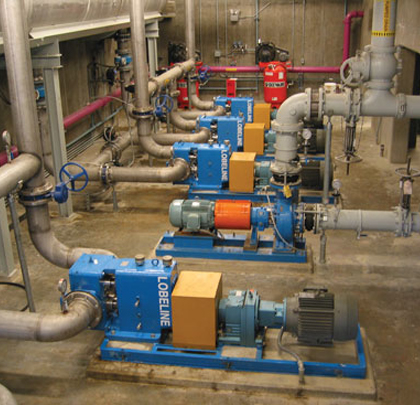Lubricant contamination originates from a number of possible sources and can also be a factor in so-called unexplained repeat failures. As if it requires recommending the obvious: Let’s be sure the lube in a pump’s bearing housing is kept clean. Even the most outstanding lubricant cannot save a bearing unless the oil is kept clean. This is where bearing housing protector seals are of value (see reference 1).
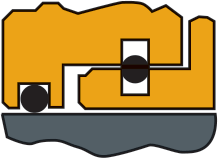
Figure 10
BEARING HOUSING PROTECTOR SEALS
Unless process pumps are provided with suitable bearing housing seals, an interchange of internal and external air (called “breathing”) takes place during alternating periods of operation and shutdown. Bearing housings “breathe” in the sense that rising temperatures during operation cause air volume expansion, and decreasing temperatures at night or after shutdown cause air volume contraction. Open or inadequately sealed bearing housings promote this back-and-forth movement of moisture-laden and dust-containing ambient air. But, simply adding bearing protector seals could change windage or housing-internal pressure patterns in unforeseen ways. This, too, we must recognize as a potential source of “unexplained” failures in housings without internal balance holes (see figure 5 in part 2 of this series, “Insist on Better Pumps,” Modern Pumping Today, February 2013: 30).
Ideally, housings should not invite breathing and the resulting contamination. There should be little or no interchange between the housing interior air and the surrounding ambient air. The breather vents shown earlier in figure 3 (see Part 2, “Insist on Better Pumps,” 28) can often be removed and plugged. Don’t be shocked by that statement. Many hundreds of millions of refrigerators and automotive air conditioning systems operate with neither vents nor breathers. Conceivably, old-style bearing housing seals allow an O-ring to contact an O-ring groove, as depicted in figure 10. Contact with sharp-edged grooves invites dynamic O-rings to scrape. That’s another disclosure which should not shock us; none of us would think that sliding our fingers over a knife is without risk. Abraded elastomer shavings can contaminate the lubricant and cause oil to change color. Also, using only a single O-ring for clamping the rotor to the shaft makes the rotor less stable than if two rings are used for clamping duty.
Visualize rotor instability by mentally removing the stationary component in figure 10. The rotor pivots around the clamping O-ring and destructive vibration would occur at high speeds. We could study the rotor dynamics of such a situation and spend a nice sum on doing research. Or, we might reach the same common-sense conclusion by giving it some thought. Two clamping O-rings will provide more stability than one single clamping O-ring.
In essence, bearing protector seals can greatly improve both life and reliability of rotating equipment by safeguarding the cleanliness of the lubricating oil. However, bearing protector seals add little value if oil contamination originates with oil ring wear, or if pressure-unbalanced constant level lubricators are used that allow air and moisture to intrude, or if the oil is not kept at the proper oil level, or if the bearing housing design disregards windage concerns, or if water enters into the oil.
We know all about see-through containers at the bottom of the pump bearing housing. However, by the time water becomes visible in such a “sludge cup container,” the saturation limits of oil-in-water will have been exceeded and much damage could have been done to the bearings. We can deduce that free water in the oil is a symptom of not having the right bearing protection. Our reliability focus should be on treating the root cause, not the symptom. We should prevent water from reaching the bearings in the first place. These proactive and precautionary thought processes are at the core of this tutorial on pump failure prevention.
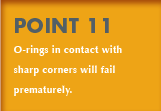
RANKING THE DIFFERENT LUBE APPLICATION PRACTICES
Although oil ring lubrication is widely used, it is relatively maintenance-intensive and ranks last from the author’s experience and risk reduction perspective. Next, flinger discs have been used for many decades and allow operation at higher DN values than oil rings. Because they are firmly clamped to the shaft there is far less sensitivity to installation and maintenance-related deviations. On the other hand, non-clamped flinger discs were tried a few decades ago, and with very disappointing results. API-610 disallows push-on flingers and some other low-cost oil application components.
Plant-wide oil mist lubrication systems are ranked ahead of flinger discs. Oil mist has proven superior to conventional lubricant application since the late 1960s. Pump bearing failure reductions ranging from 80 to 90 percent have been reported by Charles Towne of Shell Oil, and many others (see references 2 and 3). Charles Towne performed tests on identical process units at Shell Oil and deserves much credit for seminal work on the subject.
The highly beneficial in-plant, real-life results reported by Towne refer to pure oil mist, not purge mist. Pure oil mist is an oil-air mixture with a volumetric ratio of 1: 200,000. The oil is atomized to globule form and carried by the air, applied in modern plants as shown in figure 11. The same illustration, figure 11, could be used to depict liquid oil spray. Liquid oil spray is sometimes called “jet oil” lubrication (see references 4 and 5).
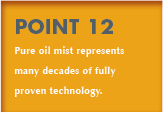
ADVANTAGES AND DISADVANTAGES OF OIL-MIST LUBRICATION
The advantages and disadvantages of oil-mist lubrication as compared to the lesser ranked, conventionally applied, oil lubrication are usually summarized as follows:
Advantages:
- Reduced bearing failures of 80 to 90 percent.
- Lower incremental bearing operating temperatures of 10 to 20 degrees Fahrenheit (5 to 11 degrees Celsius).
- No recirculation of bearing wear or debris particles.
- Slight positive system pressure eliminates contaminant entry and fully protects standby equipment.
- Electric motor drivers are included in plant-wide oil mist systems at true best-of-class performers. The incremental cost of including motors in a plant-wide oil mist system is quite minimal and has been estimated to add 10 percent to the system’s cost. All types of motor leads are acceptable as long as the correct potting compound is used in the junction box. Oil intrusion into motors is acceptable and excess oil will drain at weep holes. If needed, oil mist flow through bearings is usually accomplished during the first bearing replacement. However, flow-through passage is only needed in thrust-loaded motor bearings. Hundreds of vertical pump motors at several petrochemical plants have been in uninterrupted use for decades. Every one of these vertical motors is using through-flow oil mist. A plant in the Houston area commissioned 132 vertical pump motors in 1978 and there had been no failures as of early 2012.
- Reduced energy costs of 3 to 5 percent.
- Reduced oil consumption of about 40 percent.
- No moving parts.
- Reduced maintenance; no constant level lubricators; no oil rings; no flinger discs.
- Simplified lube oil management. (With closed oil mist systems, disposal and collection of stray mist is no longer an issue. Closed systems are preferred by users who are serious about conservation of resources and take action to do something about it.)
Disadvantages:
- Higher initial investment.
- Must consider cost of low dew point (dry) compressed air. (Of course, remote installations lacking utilities may—at first—not be able to justify oil mist, although a different picture often emerges when the preservation of standby bearings is factored into their cost justification equations).
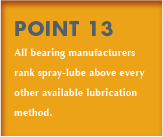
SPRAY-LUBRICATED PUMP BEARINGS
The world’s premier bearing manufacturers are unanimous in ranking spraying oil into the bearing cage area as superior to all other lube application methods, including oil mist. To effectively spray oil into the bearing areas, the lubricant (“jet oil”) has to be pressurized. External means of pressurization are well known; they exist in millions of shaft-driven governors and in auxiliary lube skids and similar lubricating packages where oil is typically pressurized, filtered, cooled and supplied to sleeve bearings. Similar means of providing pressurization and filtration are difficult to incorporate in the standard process pump bearing housing. Therefore, new bearing housing designs may be required. No cooling will be needed if high-grade synthetics are used on rolling element bearings. (Note, again, that oil mist and oil spray (“jet oil”) are completely different application methods. Each of the two different oil mist methods is described in reference texts by SKF, MRC, and others).
Keeping these facts in mind, figure 12 incorporates a number of very important recommendations for the truly reliability-focused:
- It establishes that pump bearing housings need not be symmetrically configured. (Asymmetry is visualized by looking into the pump shaft. The distance to the right edge of the bearing housing is not the same as the distance to the left edge of the bearing housing. The additional volume thus gained will accommodate a small oil pressurization pump; this small pump is to be arranged inside the process pump’s bearing housing).
- A box-like geometry with a flat cover and ample space to incorporate a wide range of oil pumps is feasible. Box-like bearing housings for process pumps would open up a host of new and inventive solutions. These might incorporate shaft-driven or other reliable self-contained means of oil application pumps. The oil application pump would take suction from an increased-size oil sump.
- The main process pump shaft need not be in the geometric center of the box.
- Flat surfaces would invite clamp-on, screw-in or flange-on oil pumps.
- Oil pressurized by the oil application pump would be routed through a filter and hydraulic tubing to spray nozzles incorporated in the end caps. Therefore, the cross-section view of a bearing housing with oil spray would be identical to the one shown for oil mist in figure 11 (see reference 6).
- Internal pressure equalization and windage issues would never again be a concern.
- The incremental cost of superior bearing housings would be more than matched by the value of avoided failures.

Figure 11 – Oil mist lubrication applied to a pump bearing housing in accordance with API-610, 10th Edition (see reference 6). With oil spray lubrication, liquid oil would enter at the nozzles. Note dual mist (or, for spray lube application, dual liquid oil) injection points. Observe dual-face bearing housing seals that prevent oil mist (or oil spray) from escaping to atmosphere.
In figure 11 and with either oil mist or oil spray there would be no oil rings, flinger discs, or constant-level lubricators. Because the mist (or spray) application nozzles shown here are relatively close to the bearings, oil mist flow or the stream of liquid oil will overcome windage. While this jet oil or oil spray lube application method seems like a bold idea, the method is extensively documented by MRC and SKF, also in at least seven of our many reference texts, among them reference 7. This lubrication method is very often used in military aircraft and we certainly take no credit for devising it.
- The duty imposed on self-contained oil spray pumps would be quite benign compared to other known, reliable, shaft-driven pumping technologies or services.
- Oil filtration would be easy.
- The elimination of oil rings and constant-level lubricators would be a very positive reliability improvement step.
- Part of the energy requirement of an oil application pump would be re-gained in the form of reduced bearing frictional losses.
With spray lubrication, much needed oil application innovation would benefit the drive end and thousands of repeat failures of pumps would no longer occur. However, as of today, little interest has been shown by manufacturers and users to redesign pump bearing housings.
The market drives these developments. If the buyers are happy with repeat failures and the manufacturers benefit from the sale of spare parts, it will be business as usual. Still, and at the risk of stubbornly bucking the trend: As responsible engineers, we should advocate changes in mindsets. As realists we are under no illusions as to where some users and manufacturers will be when the dust settles: We will never convince or even reach some of them. All we wanted to do is explain things to those whose reliability focus extends beyond “business as usual” and who are interested in asking for lower risk oil application alternatives.
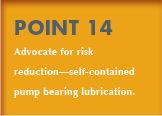
AVOID REPEAT FAILURES
As of 2012, some process pumps continue to experience costly repeat failures. Motivated reliability professionals and informed users can avoid these and will appreciate information on how to do better. The proposed new minimum requirements for reliability-focused pump users should aim for:
- Upgrading and getting away from maintenance-intensive oil rings and, if possible, constant level lubricators.
- As a matter of routine, the housing or cartridge bore must have a passage at the six o’clock position to allow pressure and temperature equalization and oil movement from one side of the bearing to the other. Note that such a passage was shown in figure 3 (see Part 2, “Insist on Better Pumps,” 28) for the radial bearing, but not for the thrust bearing set.
- With proper bearing housing protector seals and the right constant level lubricators, breathers (or vents) are no longer needed on bearing housings. The breathers (or vents) should be removed and one of the openings in figure 3 can often be plugged.
- As a minimum, a pressure-balanced constant level lubricator should be supplied and its balance line should be connected to the breather port located closest to it.
Bearings should be mounted in suitably designed cartridges and loose slinger rings (oil rings) should be avoided or, in some high DN cases, disallowed. - Suitably designed flinger discs should be secured to the shaft whenever the oil level was lowered to accommodate the need to maintain acceptable lube oil temperatures (i.e., for pumps operating with DN-values in excess of 6,000).
- Modern and technically advantageous versions of bearing housing protector seals should be used for both the inboard and outboard bearings. Lip seals are not good enough, and neither are outdated rotating labyrinth seal designs.
- Understand that the implementation of true reliability-thinking must strongly support moves away from traditional bearing housings. These moves should push for exploration of the alternatives alluded to in figure 12.
Knowledgeable engineers can prove that things tend to malfunction in the real world, and it’s in the user’s best interest to reduce failure incidents and downtime risk. Plain logic should lead to full agreement on this premise: As we get further and further away from solid training and from taking the time needed to do things right, we become ever more vulnerable. One way to counteract this vulnerability is by designing-out maintenance.
Designing-out maintenance starts with simple upgrade measures that some users implemented thirty years ago, although others are disregarding these measures to this day. Designing-out maintenance culminates in re-thinking the entire bearing housing configuration and upgrading the way oil is applied to rolling element bearings (see reference 8).
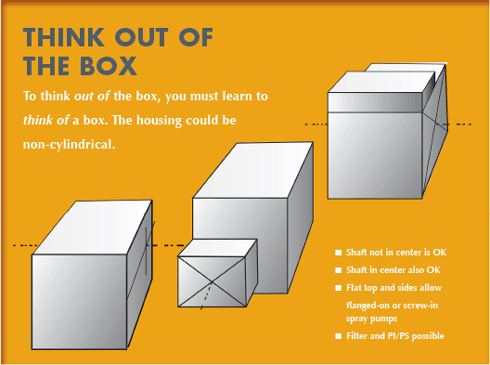
BETTER PUMPS MAY NOT BE THE CHEAPEST PUMPS
In late 2008, the purchasing entity representing a large reliability-focused plant in the United States had thoughtfully and deliberately specified better pumps. The user wanted better pumps and was willing to pay for the better product. But the buyer’s improvement requests were declined by every one of the vendor companies that responded to an invitation to bid. The disappointed owner-user company suggested an article or presentation that would get out the message to users and manufacturers alike: Better pumps are possible. Understand why reliability-focused users need them and realize why, for the value-seeking purchaser, certain “standard products” are no longer good enough.
I have focused on getting extended and trouble-free operation from pump drive ends and want to again point out that stand-alone appendices and checklists have been published in many articles and books. These and many others elaborate on the steps needed to give the value-oriented user community pumps that operate for six or more years before repairs are needed. Trends that cheapen process equipment are not healthy and reliability professionals should discourage these trends. ■
REFERENCES
1. Bloch, Heinz P.; “Pump Wisdom” (2011), John Wiley and Sons, New York, NY (ISBN 9-781118-041239)
2. Towne, C.A; “Practical Experience with Oil Mist Lubrication,” Lubrication Engineering, Vol. 39 (8), 496-502 (1983).
3. Bloch, Heinz P. and Abdus Shamim; “Oil Mist Lubrication—Practical Application” (1998), Fairmont Press, Lilburn, GA (ISBN 088173-256-7).
4. MRC Bearings General Catalog 60, “TRW Engineer’s Handbook,” Second Edition (1982), 197.
5. Bloch, Heinz P.; “Practical Lubrication for Industrial Facilities,” Second Edition (2009), Fairmont Press, Lilburn, GA (ISBN 088173-579-5)
6. American Petroleum Institute, Alexandria, VA, API-610, “Centrifugal Pumps,” Tenth Edition, 2009.
7. Bloch, Heinz P. and Allen Budris; “Pump User’s Handbook—Life Extension,” Third Edition (2010), Fairmont Press, Lilburn, GA (ISBN 0-88173-627-9).
8. Bloch, Heinz P.; “Inductive Pumps Solve Difficult Lubrication Problems,” Hydrocarbon Processing, September 2001.
_________________________________________________________________________
ABOUT THE AUTHOR
Heinz P. Bloch, P.E., is one of the world’s most recognized experts in machine reliability and has served as a founding member of the board of the Texas A&M University’s International Pump Users’ Symposium. He is a Life Fellow of the ASME, in addition to having maintained his registration as a Professional Engineer in both New Jersey and Texas for several straight decades. As a consultant, Mr. Bloch is world-renowned and value-adding. He can be contacted at heinzpbloch@gmail.com.
_________________________________________________________________________
MODERN PUMPING TODAY, April 2013
Did you enjoy this article?
Subscribe to the FREE Digital Edition of Modern Pumping Today Magazine!
![]()


